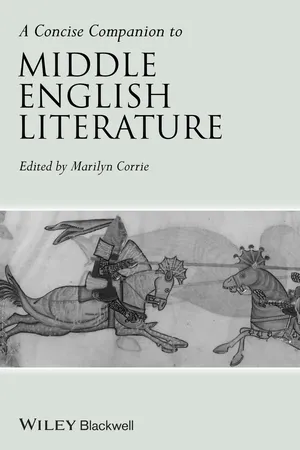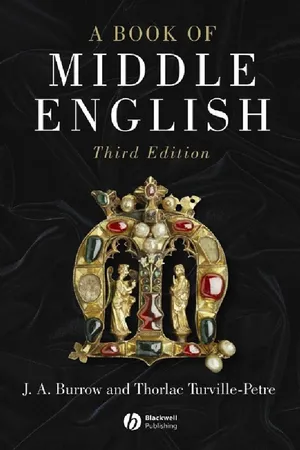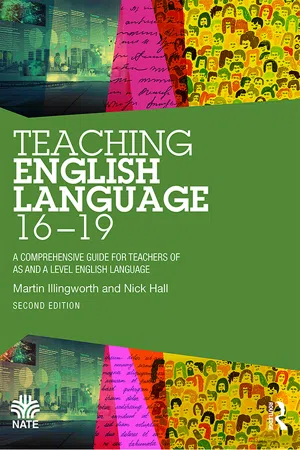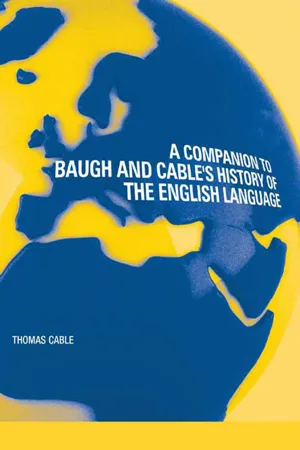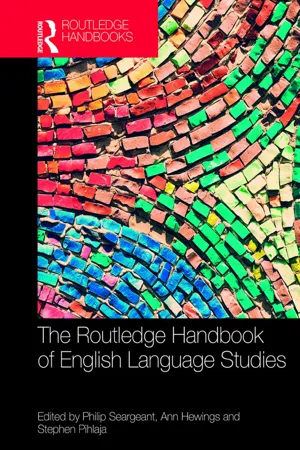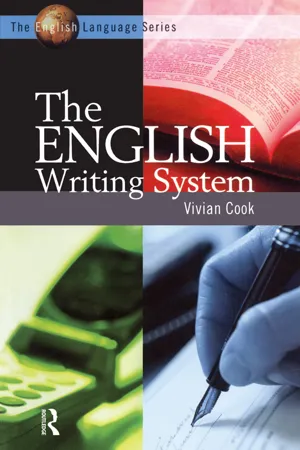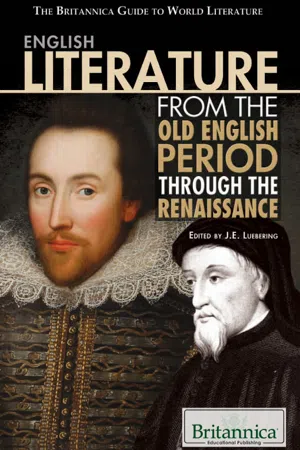Languages & Linguistics
Middle English
Middle English refers to the stage of the English language spoken from around 1100 to 1500 AD. It developed after the Norman Conquest and was characterized by significant changes in grammar, vocabulary, and pronunciation. During this period, English absorbed a large number of French and Latin words, leading to a rich and diverse linguistic landscape.
Written by Perlego with AI-assistance
Related key terms
Related key terms
1 of 4
Related key terms
1 of 3
10 Key excerpts on "Middle English"
- eBook - ePub
- Marilyn Corrie, Marilyn Corrie(Authors)
- 2013(Publication Date)
- Wiley-Blackwell(Publisher)
Part III
Writing in Middle English; Writing in England
Passage contains an image
Chapter 7
Language
Jeremy J. SmithDefining Middle English
The term ‘Middle English’ generally refers to the period between the Norman Conquest of AD 1066 and the arrival of printing in England in 1476, as opposed to ‘Old English’ (before 1066) and ‘New’ or ‘Modern English’ (after 1476). It should of course be noted that the correspondence between language-state and date is approximate: people did not wake up on the morning after the Norman Conquest, or after the arrival of printing, speaking in a radically different way. However, the connection between the form of the language and these two historical events is, as we shall see, important.The typology ‘Old–Middle–Modern’ with reference to English was established by scholars in the second half of the nineteenth century. The typology has limitations, but it does capture the differences between each stage. ‘Prototypical’ Middle English differs from Old English in all levels of language traditionally distinguished. Thus, in vocabulary, Middle English (unlike Old English) is the period when large numbers of words enter English from French; early loans were taken from Norman French, but after around 1250 a mass of Central French vocabulary starts to be recorded as part of English usage. In grammar, Middle English is traditionally seen as the period of ‘reduced inflection’. In Old English there was a comparatively large number of inflectional markers – endings added to words – flagging categories such as case, number and gender. During the course of the Middle English period, these markers were significantly reduced, and other so-called ‘discourse-tracking’ mechanisms were introduced to compensate for the reduction, such as a more fixed word order, more use of prepositions, and a more distinctive system of pronouns (compare Present-Day English ‘he’, ‘she’, ‘it’ etc.). Developments in the sound-system (phonology) were reflected in the evolution of the writing-system; phonological variation was reflected in extreme written-system (graphological) variation between individual texts – hence Middle English has been called ‘the age of written dialects’. - eBook - ePub
- J. A. Burrow, Thorlac Turville-Petre(Authors)
- 2013(Publication Date)
- Wiley-Blackwell(Publisher)
Part One 1 Introducing Middle English 1.1 THE PERIOD The term ‘Middle English’ has its origins in nineteenth-century studies of the history of the English language. German philologists then divided the history into three main periods: Old (alt-), Middle (mittel-), and New or Modern (neu-). Middle English is commonly held to begin about 1100–50 and end about 1450–1500. Unlike periods in political history, many of which can be dated quite precisely if need be (by a change of monarch or dynasty or regime), linguistic periods can be defined only loosely. Languages change all the time in all their aspects – vocabulary, pronunciation, grammatical forms, syntax, etc. – and it is impossible to decide exactly when such changes add up to something worth calling a new period. Yet, for all this lack of precision, it seems clear that the language of a mid-twelfth-century writing such as our extract from the Peterborough Chronicle (text 1) differs sufficiently from Old English to count as belonging to a new period. 1.1.1 From Old to Middle English The Old English described in our companion volume, Mitchell and Robinson’s Guide to Old English, is based on the language of the West-Saxon kingdom as it was written in the days of King Alfred of Wessex (d. 899). It was the English of this part of the country which, in the last century before the Norman Conquest in 1066, came to be accepted as the standard written form of English. People went on talking in their own various dialects; but most of the English writings set down at this time (including most Old English poetry and prose known to us) conform to this Late West-Saxon standard language. As is usually the case with such standards, this written English owed its predominance to a political fact: the predominance of Wessex itself under King Alfred and his successors over the other old kingdoms of Anglo-Saxon England - eBook - ePub
History of English
A Resource Book for Students
- Dan McIntyre(Author)
- 2020(Publication Date)
- Routledge(Publisher)
section A : namely, that the division of English into ‘periods’ is governed as much by non-linguistic factors as by linguistic ones, and that such divisions are essentially artificial. Language, as we have already discussed, is a process rather than a physical substance.B3.1 The context of change
If English is your first language, you are perhaps likely to feel more at home with Middle English than with Old English. The vocabulary is more readily recognisable that that of Old English and the grammatical structure seems closer to Present Day English than Old English. Nevertheless, there are still significant differences between Middle English and Present Day English and, although to begin with it may seem easier to understand, in many ways Middle English is harder to get to grips with than Old English. This is in part because of the variety of dialects represented in Middle English manuscripts. There was no national standard form of English in the Early Middle English period and scribes wrote in the dialect of wherever in the country they happened to come from. Spellings and grammatical forms varied between dialect areas, and we can assume from this that pronunciation varied widely too. It is, then, impossible to describe a Middle English ‘norm’, since none existed. Variation and difference were characteristic features of Middle English at its early stage, and while variation is a feature of English at each of its stages of development, the difference is that in the Middle English period there was no standard form available for scribes to use. By comparison, in the Old English period a form of standardisation had taken place which saw the West Saxon dialect become the prominent written form (see A2.2 ). Indeed, such was its influence that this form was used beyond the regional boundaries of Wessex. Nevertheless, there are some general points that can be made about Middle English when compared to Old English, and these will be the focus of this unit.In A3 we saw that one of the external events that contributed to the linguistic development of Old English into Middle English was the Norman Conquest of 1066. We must be careful, however, not to attribute linguistic change to this factor alone. The accession of William the Conqueror to the throne led to a rise in the number of French speakers in the country as William appointed his own nobles to prominent administrative positions, and French was eventually to influence English significantly, particularly its vocabulary (see B3.4 ). But the Norman Conquest did nothing to threaten the survival of English, since English remained the language spoken by the vast majority of the people, most of whom would have had no contact at all with the French ruling elite. English, while influenced by French, was also affected by the Scandinavian languages spoken by the Viking invaders, and a combination of factors was responsible for the development of Old English into Middle English (see B3.3 - eBook - ePub
Teaching English Language 16-19
A Comprehensive Guide for Teachers of AS and A Level English Language
- Martin Illingworth, Nick Hall(Authors)
- 2018(Publication Date)
- Routledge(Publisher)
As well as these ‘internal’ features of the texts of Old English, you could discuss with your group how they feel about having become detached from the origins of their language. I would suggest that most merely feel that it is mildly irritating not to be able to read texts in museums. It perhaps makes the past feel even more distant and strange. You might reflect with your class upon the plight of languages which are becoming extinct, subsumed by bigger languages like English. For example, the last speaker of the language Kasabe, spoken in Cameroon, died in November of 1996 before the language had been documented by linguists (there are many languages in the world that do not have a written form). It would surely be more than ‘mildly irritating’ if that speaker were a relative of yours and he took with him all of your family history. Languages are the repositories of history, the gateposts to identity and cultural understanding.Middle English Period 1150–1500AD
The Canterbury Tales , Geoffrey Chaucer. Chaucer is an important writer for linguistic study because of the sheer range of voices portrayed in his choice of characters on their pilgrimage to Canterbury from London. Chaucer chose his characters from all walks of life and they bring with them the multiplicity of accents, dialects, high-brow foreign borrowings and earthy Anglo-Saxon vocabulary.The Lord’s Prayer . It can be useful to contrast your Old English version of The Lord’s Prayer (above) with a Middle English version. This makes a good introduction to the ways in which the language has moved on between the two general time periods. Students will undoubtedly note that this text is much more accessible. So, you explore why they can now, not only identify the text, but fully understand it.Oure fadir that art in heuenys, Halewid be thy name. Thy kingdom come to, Be-thy wille don as in heuene an in erthe. Give to us this day oure breed ouer other substaunse, And furgiue to us oure dettouris, And leede us not into temptacioun, But delyuere us from yuel. Amen.Piers Plowman , William Langland. In a period when the English language had made extensive borrowings from French, Langland’s verse is notably lacking in such borrowings. This text deals with the plight of the working classes of the Midlands area and is written in alliterative verse making use of the voice of the peasant classes. For the linguist, this text is a good reminder that each text must be considered on its own merits rather than general notions of what one might expect to see in a text written in 1390.__________________________________This period is dominated by the invasion of the Norman French in 1066. English became a second-, or indeed third-class language in its own country behind the French of the ruling classes and the language of learning and religion, Latin. Writing in English all but disappears after the Norman Conquest until around 1200. English became an oral language, not thought fitting for serious and important matters. - eBook - ePub
- David Graddol, Dick Leith, Joan Swann, Martin Rhys, Julia Gillen, David Graddol, Dick Leith, Joan Swann, Martin Rhys, Julia Gillen(Authors)
- 2020(Publication Date)
- Routledge(Publisher)
Englisc ('English') was first used to denote both people and language under his auspices.In the tenth century there was another revival of learning and literary activity, this time associated with the influential Benedictine monasteries. The scriptorium of the monastery at Winchester, producing texts in the West Saxon dialect, seems to have made considerable efforts to regularise spellings and this has been seen as a move in the direction of standardisation in English. (See another book in this series, Graddol et al, 2007, for further discussion of this issue).Most extant Old English manuscripts date from the late Old English period and they preserve, not only translations of learned Latin texts, but also an important body of vernacular literature in prose and poetry. Some of the poems are religious, following the example set by Caedmon, and others (such as Beowulf) stem from inherited Germanic traditions.So far we've looked at Old English: where it came from, what it was like, how certain aspects of it changed, and how the process of change might be explained. We now move on to a different period of the English language, that known as 'Middle English'.2.6 The transition to Middle EnglishWe have seen that the English language was undergoing significant change during the early part of the tenth century. In 1066 an event occurred that was to have a profound effect on this process. In that year a French-speaking dynasty from the dukedom of Normandy was installed in England. This external event has long been seen as decisive, not only for the history of England (and consequently Britain) but for the English language as well. For scholars who have viewed the history of England and English as one of unbroken progress, the Conquest has often been a milestone on the road to 'civilisation', playing a key role in the development of Modern English. But another view, perhaps more widely held, sees the events of the Conquest in terms of (an at least temporary) decline: as the wrecking of a relatively sophisticated 'native' Anglo-Saxon culture by a 'foreign' and tyrannical French one, so that the continuity of English culture was ruptured and the continued existence of the English language threatened. - Thomas Cable(Author)
- 2013(Publication Date)
- Routledge(Publisher)
23. Despite the changes in the English language brought about by the Norman Conquest, in what ways was the language still English?24. What was the main source of Latin borrowings during the fourteenth and fifteenth centuries?25. In which Middle English writers is aureate diction most evident?26. What tendency may be observed in the following sets of synonyms: rise—mount— ascend, ask—question—interrogate, goodness—virtue—probity?27. What kind of contact did the English have with speakers of Flemish, Dutch, and Low German during the late Middle Ages?28. What are the five principal dialects of Middle English?29. Which dialect of Middle English became the basis for Standard English? What causes contributed to the establishment of this dialect?30. Why did the speech of London have special importance during the late Middle Ages?7.2 FROM OLD TO Middle English: VOWELS17.2.1 Changes in the Old English VowelsIn the phonological developments from Old English to Middle English, five of the Old English simple vowels changed in quality, and the four Old English diphthongs became simplified to monophthongs.The Old English words below contain vowels that underwent regular developments in Middle English. The consonants in these words for the most part remained unchanged. Transcribe phonetically the Old English word; then indicate the “stressed vowel change” by writing the number of the appropriate rule from the list of nine changes above; finally, transcribe phonetically the Middle and Modern English forms. Remember that unstressed Old English vowels reduced to [ə] in Middle English. For Modern English do not mark length.7.2.2 Formation of New DiphthongsIn addition to the changes in the Old English vowels, six new diphthongs appeared in the language. The full history of these diphthongs is complex because of the varied sources from which a single diphthong could derive. Different phonological contexts in Old English resulted in Middle English [ɑʊ], for example, and that diphthong also entered Middle English directly from Old French and Old Norse. The representative sources that are given below for five of the six diphthongs are all of the same phonological type: two separate elements in Old English (simple vowel plus glide or fricative) which merged to produce a single diphthong in Middle English. This is the most important of the contexts that produced the new diphthongs. The sixth diphthong is one that came from French, [ɔι], a sound that English still has in choice, royal, annoy- Philip Seargeant, Ann Hewings, Stephen Pihlaja, Philip Seargeant, Ann Hewings, Stephen Pihlaja(Authors)
- 2018(Publication Date)
- Routledge(Publisher)
Another way in which the application of modern linguistic methods has revolutionised the historical study of English is in the field of dialectology. As we saw above, the historical study of English had previously focused heavily on the evolution of the standard language, ignoring the rich evidence for the history of English dialects. This evidence is particularly plentiful in the Middle English period, since there was no standard variety of the written language. For this reason, changes in the methods of historical dialectology in the light of modern approaches are best illustrated by a consideration of the work of the Middle English Dialect Project. This project was instigated by M.L. Samuels and A.I. McIntosh of the universities of Glasgow and Edinburgh respectively, in the 1950s. Drawing on methodological insights from the linguistic survey of the Modern Scots dialects, they set out to produce an atlas of the dialects represented by the Middle English written record. Despite being restricted to exclusively written materials, the Middle English Dialect project proceeded on the assumption that written variation could be subject to dialect mapping in precisely the same manner as had been achieved with spoken differences in the Modern Scots dialect survey. In seeking to apply modern dialectological techniques to the Middle English dialects, the project encountered a number of challenges. An obvious limitation imposed by the sources concerned the lack of access to the spoken language: a problem that affects all historical studies that pre-date the invention of audio recording technology. As well as lacking direct access to the spoken language, the Middle English dialect survey was limited by the lack of localised documents – most Middle English manuscripts were written by anonymous scribes and do not preserve important information about the date or location of their copying. The survey overcame this limitation by developing the ‘fit-technique’; manuscripts were ‘fitted’ on the dialect map by comparing their linguistic forms with those recorded in manuscripts where the location of copying was known (‘localised’ or ‘anchor’ texts) (Benskin 1991). The result of this was the localisation of around 1,000 manuscripts copied in the period between 1350 and 1450, accompanied by extensive linguistic profiles of representative data and schematic maps indicating the distribution of representative linguistic items (McIntosh et al. 1986).- eBook - ePub
- Vivian J Cook(Author)
- 2014(Publication Date)
- Routledge(Publisher)
The only punctuation marks in Middle English consisted of ‘a low dot, an inverted semicolon and a virgule (/)’ (Strang 1970: 159), used to indicate lengths of pause — short, medium and long. Like Old English, ME was correspondence-based rather than grammatically based and lacked marks such as the question mark and the exclamation mark that indicate grammatical punctuation. The normalized texts are therefore imposing a punctuation system on Middle English; the original ME writing system is being sacrificed to the convenience of a modern reader. 6.4 From Early Modern English to Modern English Early Modern English refers to English between about 1500 and 1700. The first printed books in English came just before the start of this period, coming from the first English printers established by William Caxton in 1477. Most of the subsequent history of the English writing system has concerned the printed word rather than the hand-written word. To a large extent, Early Modern English writing was standardized across the different regions of England, Scotland and Wales, though there were considerable changes in the spoken language over this period. It is often said that the pressure to standardize the spelling came from printers, whose descendants still play this role in modern times, as seen in Chapter 4. Brengelmann (1980) argues, however, that Elizabethan writers would have insisted that their views took precedence over those of any printing hack and that standardized spelling worked against printers by depriving them of flexible alternative spellings of words. For example, few of the actual spellings introduced by William Caxton have come down to Modern English - Britannica Educational Publishing, J.E. Luebering(Authors)
- 2010(Publication Date)
- Britannica Educational Publishing(Publisher)
CHAPTER 2
THE Middle English PERIODB y the end of the Old English period, English had been established as a literary language with a polish and versatility unequaled among European vernaculars. The Norman Conquest (1066) worked no immediate transformation on either the language or the literature of the English.EARLY Middle English POETRY
Older poetry continued to be copied during the last half of the 11th century. Two poems of the early 12th century—“Durham”, which praises that city’s cathedral and its relics, and Instructions for Christians , a didactic piece—show that correct alliterative verse could be composed well after 1066. But even before the conquest, rhyme had begun to supplant, rather than supplement, alliteration in some poems, which continued to use the older four-stress line, although their rhythms varied from the set types used in classical Old English verse. A postconquest example is “The Grave,” which contains several rhyming lines. A poem from The Anglo-Saxon Chronicle on the death of William the Conqueror, lamenting his cruelty and greed, has more rhyme than alliteration.INFLUENCE OF FRENCH POETRYBy the end of the 12th century, English poetry had been so heavily influenced by French models that such a work as the long epic Brut (c . 1200) by Lawamon, a Worcestershire priest, seems archaic for mixing alliterative lines with rhyming couplets while generally eschewing French vocabulary. The Brut draws mainly upon Wace’s Anglo-Norman Roman de Bru t (1155; based in turn upon Geoffrey of Monmouth’s Historia regum Britanniae [History of the Kings of Britain]), but in Lawamon’s hands the Arthurian story takes on a Germanic and heroic flavour largely missing in Wace. The Brut exists in two manuscripts, one written shortly after 1200 and the other some 50 years later. That the later version has been extensively modernized and somewhat abridged suggests the speed with which English language and literary tastes were changing in this period. The Proverbs of Alfred was written somewhat earlier, in the late 12th century. These proverbs deliver conventional wisdom in a mixture of rhymed couplets and alliterative lines, and it is hardly likely that any of the material they contain actually originated with the king whose wisdom they celebrate. The early 13th-century Bestiary mixes alliterative lines, three- and four-stress couplets, and septenary (heptameter) lines, but the logic behind this mix is more obvious than in the Brut and the Proverbs , for the poet was imitating the varied metres of his Latin source. More regular in form than these poems is the anonymous Poema morale- Vivian Cook, Des Ryan, Vivian Cook, Des Ryan, Vivian Cook, Des Ryan(Authors)
- 2016(Publication Date)
- Routledge(Publisher)
Part IIThe history and development of the English writing systemPassage contains an image
7The etymological inputs into English spellingSimon HorobinMethods and issues
English spelling is a concoction of written forms drawn from a variety of languages through processes of inheritance and borrowing. At every period in its history, the English lexicon contains words inherited from earlier stages, as well as new words introduced from foreign languages. But this distinction should not be applied too straightforwardly, since inherited words have frequently been subjected to changes in their spelling over time. Similarly, while words drawn from foreign languages may preserve their native spellings intact, they frequently undergo changes in order to accommodate to native English spelling patterns. We can trace such patterns of change by analysing spelling variation across time using historical dictionaries. The principal resource is the Oxford English Dictionary (OED), which includes detailed etymologies and a list of variant forms with accompanying dates. Inevitably these forms are just a selection of the range of alternative spellings that have been attested throughout the history of English (see Durkin, this volume). For the earliest periods of English, the Old English (650–1066) and Middle English (1066–1500) periods, these lists can be supplemented by recourse to period dictionaries, which include more detailed accounts of spelling forms found in texts written during these periods. Other valuable resources for analysing variation in spelling during the Middle English period are the Linguistic Atlas of Late Mediaeval English (McIntosh, Samuels and Benskin 1986), which supplies detailed linguistic profiles for over a thousand manuscripts copied between roughly 1300 and 1450 and its daughter project, The Linguistic Atlas of Early Middle English, covering the period 1150–1325 (Laing 2008–13). As we shall see, tracing the history of a word’s spelling is not always straightforward. One reason for this is that the spelling of a borrowed word may be altered so as to make it conform to the spelling of another language. The word phoenix, for instance, was adopted in Old English with the spelling <fenix>, using the Old English convention of using <f> for /f/ rather than signalling its Greek origins by using <ph>. This process has affected English spelling throughout its history, but was most prevalent in the late Middle and Early Modern (1500–1800) periods, when the prestige of the Latin language led to the respelling of a number of French loanwords to make them resemble their Latin equivalents. To make matters more complex, words were frequently borrowed from both Latin and French, with only slight variations in spelling. The verb intend, for instance, appears to have been derived from the Latin verb intendere. But the earliest instances of the word, first recorded in the fourteenth century, are spelled <entend>, showing that the word was in fact borrowed from French entendre. Later instances are spelled <intend>: does this mean they are borrowings directly from the Latin intendere
Index pages curate the most relevant extracts from our library of academic textbooks. They’ve been created using an in-house natural language model (NLM), each adding context and meaning to key research topics.
Explore more topic indexes
Explore more topic indexes
1 of 6
Explore more topic indexes
1 of 4
